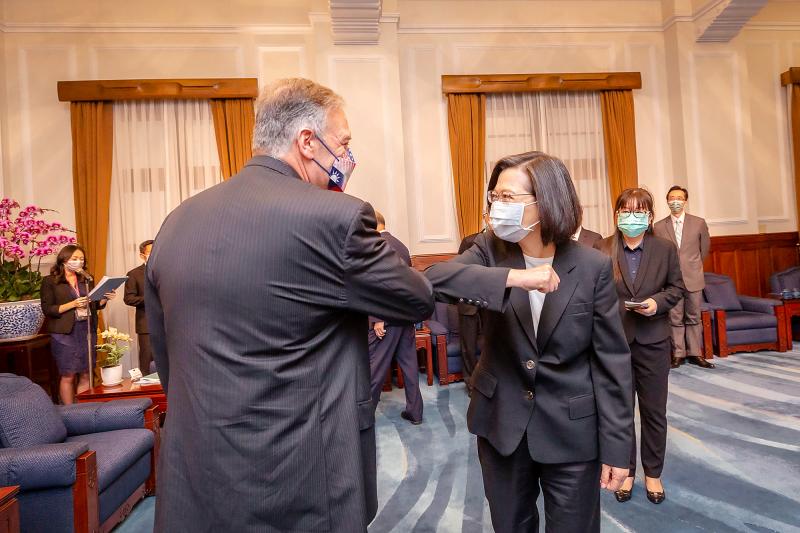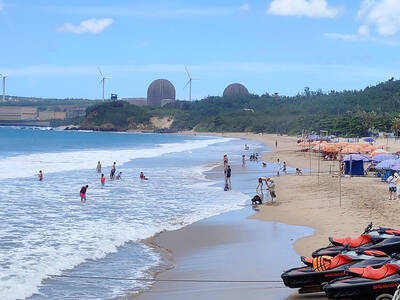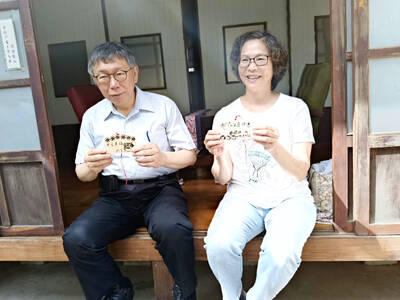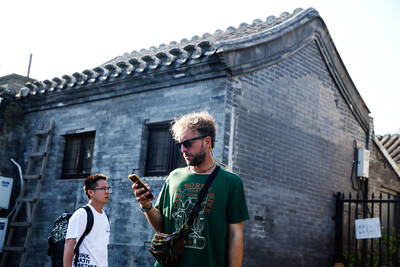Last week Chinese Nationalist Party (KMT) lawmaker and party strategist Fu Kun-chi (傅崐萁), stimulated like all us by the Russian invasion of Ukraine, argued in the legislature that Taiwan should follow “the Finnish model” and not be a “front-line country.”
Ironically, as he was making that argument, Finland, which already cooperates closely with NATO, was debating becoming a NATO member.
Fu’s remark was laughably out of touch with history. Finland became “Finlandized” only after fighting a bitter war against the Russians. Moreover, the Soviet Union agreed to recognize the independent sovereignty of Finland as part of the deal.

Photo: AFP
Imagine Beijing formally recognizing Taiwan’s independent sovereignty! That is why the whole idea of “Finlandizing” Taiwan is entirely mad. Nevertheless, it is a “solution” periodically mooted in the media and in scholarly journals (see, for example, Bruce Gilley’s comical 2010 piece in Foreign Affairs, “Not So Dire Straits: How the Finlandization of Taiwan Benefits US Security”).
NON-ALIGNED
Laugh as we might, let’s not forget that party strategist Fu’s words were actually yet another insidious instance of a long-term strategy of the KMT to sever Taiwan from its protectors, the US and Japan, and re-orient it towards China. This strategy has several simultaneous components.
One aspect of this strategy is signaled by Fu’s “Finlandization” comment: it seeks to make Taiwan “neutral” between China and the US/Japan alliance. This “neutrality” is presented in many different ways. For example, KMT candidates have several times discussed “peace treaties” with China of 30 or 50 years duration, an idea first floated in the mid-1990s by Kenneth Lieberthal, who like many people in Democratic administrations, was part of Stonebridge, a quietly influential consulting firm with a robust China business.
Back in the 2000 election ex-KMTer James Soong (宋楚瑜) floated the idea. Then-president Ma Ying-jeou (馬英九) revived it as the culmination of his “Golden Decade” policies, though he cautiously said it should be submitted to a plebiscite, in the run-up to the 2012 election (ironically, Soong, a candidate from his own party, attacked him). In the 2016 election, foredoomed KMT candidate Hung Hsiu-chu (洪秀柱) also brought up the idea.
“Neutralizing” an island by separating it from its support is also a strategy that China is using in Okinawa, where it quietly supports Okinawan independence for the same reasons it doesn’t support Taiwan independence. Such “neutrality” would make Taiwan an easy target in an invasion.
Hand-in-hand with the peace treaty idea is opposition to weapons purchases and military reforms. Indeed, in many KMT presentations on a “peace treaty” it is explicitly stated that Taiwan would no longer need much in the way of weaponry once a treaty was signed and its security assured (to his credit Ma, ever wise to the need to look pro-Taiwan, downplayed that argument). Remember the vociferous debates over weapons purchases during the administration of Chen Shui-bian (陳水扁)?
As Fu did in his diatribe last week, KMT members constantly say that the US will never come to Taiwan’s aid. Similarly, last week Ma said that the chances were low of US troops coming to Taiwan’s defense. I have heard this resistance-is-futile trope from many KMT supporters.
IRRITATE THE US AND JAPAN
Another aspect of this strategy is irritating relations with Japan (relations between the two are too strong at the moment to entirely destroy) and the US. The Senkaku Islands “dispute” is often used for this purpose. In power, KMT leaders emphasize “Taiwan’s sovereignty” over the islands, hoping also to get people to conflate Taiwan and the Republic of China (ROC).
Out of power, they demand that Democratic Progressive Party (DPP) administrations protect Taiwan’s “sovereignty” over the islands. The Fukushima food ban was part of this approach, as was the KMT’s support of the ban on US food products containing ractopamine, aimed at irritating the US. Ma’s cynical use of the comfort women issue against Japan falls under this category as well.
Fu’s argument for the Finlandization of Taiwan came in an exchange in the legislature with DPP Premier Su Tseng-chang (蘇貞昌), in which he instanced Su’s long-ago ancestry in China. Su retorted that Fu’s speech had the same tone as that of China’s Taiwan Affairs Office (TAO).
This is not by accident. Fu’s call to neutralize Taiwan via Finlandization might have been laughably out of touch, yet it was one among the many Taiwan-Ukraine parallels, the mirror of Russian dictator Putin’s long struggle to keep Ukraine out of NATO so he could invade it. Fu’s positioning of Taiwan would have a similar effect.
Indeed, it is hard to shut one’s eyes to the numerous parallels between the ethnonationalistic dreams of China and Russia. Putin seeks, as longtime Russia watcher Fiona Hill observed in an excellent interview with Politico last week, to create a “Russky Mir,” a Russian world in which Russian influence reigns supreme, most of it under Russia’s direct control. The dictator’s claims about NATO were simply a smokescreen designed to keep Ukraine out of NATO. NATO was never the issue.
This dream of imperium has its obverse echo in China’s “Century of Humiliation,” a national myth of “lost territories” which is actually a collection of expansionist fantasies, expressed in cartographic form in maps of national humiliation (國恥地圖).
The ROC and its successor modern China, like Putin, identifies with the old (Qing) empire. On the first ROC map issued in 1912, Korea and Vietnam are marked as “originally our vassal,” Taiwan is marked as lost to Japan and the map declares that the boundaries of the Qing Dynasty are the boundaries of the new ROC. Naturally, no borders are clearly marked. The development of maps continued throughout the 1920s and 30s. A privately drafted 1938 map issued for elementary school use shows that Laos, Burma, Cambodia, Thailand, Vietnam and most of Malaysia are lost territories awaiting reunification.
Putin, of course, has many times lectured his people on how his predecessors lost large amounts of territory of the old Russian empire, and how borders have changed over the centuries.
In this ethnonationalist fantasy history, both Ukraine and Taiwan are equally non-countries, and all the ethnicities contained within them are totalized and swept away, equally non-peoples.
So remember, the next time someone calls for Taiwan to be “Finlandized” that Finland, which declared independence from the fledgling USSR in 1917, is a piece of the old Russian empire that Putin appears to want returned.
Notes from Central Taiwan is a column written by long-term resident Michael Turton, who provides incisive commentary informed by three decades of living in and writing about his adoptive country. The views expressed here are his own.

Climate change, political headwinds and diverging market dynamics around the world have pushed coffee prices to fresh records, jacking up the cost of your everyday brew or a barista’s signature macchiato. While the current hot streak may calm down in the coming months, experts and industry insiders expect volatility will remain the watchword, giving little visibility for producers — two-thirds of whom farm parcels of less than one hectare. METEORIC RISE The price of arabica beans listed in New York surged by 90 percent last year, smashing on Dec. 10 a record dating from 1977 — US$3.48 per pound. Robusta prices have

A dozen excited 10-year-olds are bouncing in their chairs. The small classroom’s walls are lined with racks of wetsuits and water equipment, and decorated with posters of turtles. But the students’ eyes are trained on their teacher, Tseng Ching-ming, describing the currents and sea conditions at nearby Banana Bay, where they’ll soon be going. “Today you have one mission: to take off your equipment and float in the water,” he says. Some of the kids grin, nervously. They don’t know it, but the students from Kenting-Eluan elementary school on Taiwan’s southernmost point, are rare among their peers and predecessors. Despite most of

The resignation of Taiwan People’s Party (TPP) co-founder Ko Wen-je (柯文哲) as party chair on Jan. 1 has led to an interesting battle between two leading party figures, Huang Kuo-chang (黃國昌) and Tsai Pi-ru (蔡壁如). For years the party has been a one-man show, but with Ko being held incommunicado while on trial for corruption, the new chair’s leadership could be make or break for the young party. Not only are the two very different in style, their backgrounds are very different. Tsai is a co-founder of the TPP and has been with Ko from the very beginning. Huang has

A few years ago, getting a visa to visit China was a “ball ache,” says Kate Murray. The Australian was going for a four-day trade show, but the visa required a formal invitation from the organizers and what felt like “a thousand forms.” “They wanted so many details about your life and personal life,” she tells the Guardian. “The paperwork was bonkers.” But were she to go back again now, Murray could just jump on the plane. Australians are among citizens of almost 40 countries for which China now waives visas for business, tourism or family visits for up to four weeks. It’s